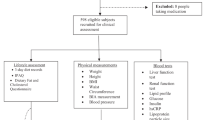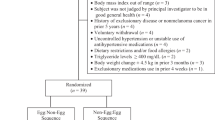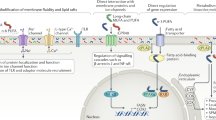Abstract
Background
Milk has a specific saturated fatty acid profile and its calcium content may change the kinetics of fat absorption.
Objective
The goal of this study was to compare the effect on LDL Cholesterol and other risk markers of four isolipidic diets differing by their fat food source, vegetable fat, spring milk fat, winter milk fat or winter milk fat supplemented with calcium, in healthy moderately hypercholesterolemic humans.
Individuals and methods
This double-blind, randomized trial with four parallel arms included 172 healthy adults with plasma LDL cholesterol (LDL-C) from 130 to 220 mg/dL and triglycerides below 300 mg/dL. Individual meal plans ensured a stable energy intake. In the three diets containing milk fat, milk fat provided 38% of energy. Vegetable fat and spring milk fat diets provided the same amount of saturated fatty acids while the winter milk fat diets were slightly richer in saturated fatty acids. Vegetable fat diet and winter milk fat diets provided the same amount of palmitic acid (7.0% EI), while the spring milk fat diet was slightly poorer in this fatty acid (5.1% EI). Cardiovascular risk markers were analyzed after 8 weeks of dietary intervention.
Results
There was no significant difference in LDL-C and other markers, except total cholesterol (TC), apo C3 and CRP. TC was significantly higher with spring milk fat than with vegetable fat.
Conclusions
In this trial, the chosen vegetable fat did not have a significant beneficial effect on LDL-C compared to dairy fat. However, sub-group analysis showed differences in TC, apo C3 and CRP. These results need confirmation and long-term studies aiming at cardiovascular endpoints are warranted.
This is a preview of subscription content, access via your institution
Access options
Subscribe to this journal
Receive 12 print issues and online access
$259.00 per year
only $21.58 per issue
Buy this article
- Purchase on Springer Link
- Instant access to full article PDF
Prices may be subject to local taxes which are calculated during checkout

Similar content being viewed by others
References
Kris-Etherton PM, Yu S. Individual fatty acid effects on plasma lipids and lipoproteins: human studies. Am J Clin Nutr. 1997;65 5 Suppl:1628S–44S.
Yu S, Derr J, Etherton TD, Kris-Etherton PM. Plasma cholesterol-predictive equations demonstrate that stearic acid is neutral and monounsaturated fatty acids are hypocholesterolemic. Am J Clin Nutr. 1995;61:1129–39.
Ginsberg HN, Barr SL, Gilbert A, Karmally W, Deckelbaum R, Kaplan K, et al. Reduction of plasma cholesterol levels in normal men on an American Heart Association Step 1 diet or a Step 1 diet with added monounsaturated fat. New Engl J Med. 1990;322:574–9.
Kelly FD, Sinclair AJ, Mann NJ, Turner AH, Raffin FL, Blandford MV, et al. Short-term diets enriched in stearic or palmitic acids do not alter plasma lipids, platelet aggregation or platelet activation status. Eur J Clin Nutr. 2002;56:490–9.
Mensink RP. Effects of stearic acid on plasma lipid and lipoproteins in humans. Lipids 2005;40:1201–5.
de Gomez Dumm IN, Brenner RR. Oxidative desaturation of alpha-linoleic, linoleic, and stearic acids by human liver microsomes. Lipids 1975;10:315–7.
Hegsted DM, McGandy RB, Myers ML, Stare FJ. Quantitative effects of dietary fat on serum cholesterol in man. Am J Clin Nutr. 1965;17:281–95.
Keys A, Anderson JT, Grande F. Prediction of serum-cholesterol responses of man to changes in fats in the diet. Lancet 1957;273:959–66.
Keys A, Anderson JT, Grande F. Serum cholesterol response to changes in the diet: IV. Particular saturated fatty acids in the diet. Metab: Clin Exp. 1965;14:776–87.
Xue C, Liu Y, Wang J, Zheng Z, Zhang Y, Zhang Y, et al. Chinese hypertriglycerideamic subjects of different ages responded differently to consuming oil with medium- and long-chain fatty acids. Biosci Biotechnol Biochem. 2009;73:1711–7.
Zhang YH, Liu YH, Zheng ZX, Wang J, Zhang Y, Zhang RX, et al. Medium- and long-chain fatty acid triacylglycerol reduce body fat and serum triglyceride in overweight and hypertriglyceridemic subjects. Zhonghua Yu Fang Yi Xue Za Zhi. 2009;43:765–71.
Cater NB, Heller HJ, Denke MA. Comparison of the effects of medium-chain triacylglycerols, palm oil, and high oleic acid sunflower oil on plasma triacylglycerol fatty acids and lipid and lipoprotein concentrations in humans. Am J Clin Nutr. 1997;65:41–5.
Tholstrup T, Ehnholm C, Jauhiainen M, Petersen M, Hoy CE, Lund P, et al. Effects of medium-chain fatty acids and oleic acid on blood lipids, lipoproteins, glucose, insulin, and lipid transfer protein activities. Am J Clin Nutr. 2004;79:564–9.
Gardner CD, Kraemer HC. Monounsaturated versus polyunsaturated dietary fat and serum lipids. A meta-analysis. Arteriosclerosis Thromb Vasc Biol. 1995;15:1917–27.
Chowdhury R, Warnakula S, Kunutsor S, Crowe F, Ward HA, Johnson L, et al. Association of dietary, circulating, and supplement fatty acids with coronary risk: a systematic review and meta-analysis. Ann Intern Med. 2014;160:398–406.
Siri-Tarino PW, Sun Q, Hu FB, Krauss RM. Meta-analysis of prospective cohort studies evaluating the association of saturated fat with cardiovascular disease. Am J Clin Nutr. 2010;91:535–46.
Harcombe Z, Baker JS, Cooper SM, Davies B, Sculthorpe N, DiNicolantonio JJ, et al. Evidence from randomised controlled trials did not support the introduction of dietary fat guidelines in 1977 and 1983: a systematic review and meta-analysis. Open Heart 2015;2:e000196.
de Souza RJ, Mente A, Maroleanu A, Cozma AI, Ha V, Kishibe T, et al. Intake of saturated and trans unsaturated fatty acids and risk of all cause mortality, cardiovascular disease, and type 2 diabetes: systematic review and meta-analysis of observational studies. BMJ (Clin Res ed). 2015;351:h3978.
Praagman J, Beulens JW, Alssema M, Zock PL, Wanders AJ, Sluijs I, et al. The association between dietary saturated fatty acids and ischemic heart disease depends on the type and source of fatty acid in the European Prospective Investigation into Cancer and Nutrition-Netherlands cohort. Am J Clin Nutr. 2016;103:356–65.
de Oliveira Otto MC, Nettleton JA, Lemaitre RN, Steffen LM, Kromhout D, Rich SS, et al. Biomarkers of dairy fatty acids and risk of cardiovascular disease in the Multi-ethnic Study of Atherosclerosis. J Am Heart Assoc 2013;2:e000092.
de Oliveira Otto MC, Mozaffarian D, Kromhout D, Bertoni AG, Sibley CT, Jacobs DR Jr., et al. Dietary intake of saturated fat by food source and incident cardiovascular disease: the Multi-Ethnic Study of Atherosclerosis. Am J Clin Nutr. 2012;96:397–404.
de Oliveira Otto MC, Lemaitre RN, Song X, King IB, Siscovick DS, Mozaffarian D. Serial measures of circulating biomarkers of dairy fat and total and cause-specific mortality in older adults: the Cardiovascular Health Study. Am J Clin Nutr. 2018;108:476–84.
O’Sullivan TA, Hafekost K, Mitrou F, Lawrence D. Food sources of saturated fat and the association with mortality: a meta-analysis. Am J Public Health. 2013;103:e31–42.
Strauss EW, Jacob JS. Some factors affecting the lipid secretory phase of fat absorption by intestine in vitro from golden hamster. J Lipid Res. 1981;22:147–56.
Vinarova L, Vinarov Z, Tcholakova S, Denkov ND, Stoyanov S, Lips A. The mechanism of lowering cholesterol absorption by calcium studied by using an in vitro digestion model. Food Funct. 2015;7:151–63.
Lorenzen JK, Nielsen S, Holst JJ, Tetens I, Rehfeld JF, Astrup A. Effect of dairy calcium or supplementary calcium intake on postprandial fat metabolism, appetite, and subsequent energy intake. Am J Clin Nutr. 2007;85:678–87.
Bachorik PS, Ross JW. National Cholesterol Education Program recommendations for measurement of low-density lipoprotein cholesterol: executive summary. The National Cholesterol Education Program Working Group on Lipoprotein Measurement. Clin Chem. 1995;41:1414–20.
Bobin-Dubigeon C, Jaffre I, Joalland MP, Classe JM, Campone M, Herve M, et al. Paraoxonase 1 (PON1) as a marker of short term death in breast cancer recurrence. Clin Biochem. 2012;45:1503–5.
Tselepis AD, Dentan C, Karabina SA, Chapman MJ, Ninio E. PAF-degrading acetylhydrolase is preferentially associated with dense LDL and VHDL-1 in human plasma. Catalytic characteristics and relation to the monocyte-derived enzyme. Arteriosclerosis, thrombosis, Vasc Biol. 1995;15:1764–73.
Martin JC, Berton A, Ginies C, Bott R, Scheercousse P, Saddi A, et al. Multilevel systems biology modeling characterized the atheroprotective efficiencies of modified dairy fats in a hamster model. Am J Physiol Heart Circ Physiol. 2015;309:H935–45.
Gordon DJ, Hyde J, Trost DC, Whaley FS, Hannan PJ, Jacobs DR, et al. Cyclic seasonal variation in plasma lipid and lipoprotein levels: the Lipid Research Clinics Coronary Primary Prevention Trial placebo group. J Clin Epidemiol. 1988;41:679–89.
Rodriguez M, Funke S, Fink M, Demmelmair H, Turini M, Crozier G, et al. Plasma fatty acids and [13C]linoleic acid metabolism in preterm infants fed a formula with medium-chain triglycerides. J Lipid Res. 2003;44:41–8.
Du Q, Martin JC, Agnani G, Pages N, Leruyet P, Carayon P, et al. Dairy fat blends high in alpha-linolenic acid are superior to n-3 fatty-acid-enriched palm oil blends for increasing DHA levels in the brains of young rats. J Nutr Biochem. 2012;23:1573–82.
Blankenhorn DH, Alaupovic P, Wickham E, Chin HP, Azen SP. Prediction of angiographic change in native human coronary arteries and aortocoronary bypass grafts. Lipid and nonlipid factors. Circulation. 1990;81:470–6.
Chivot L, Mainard F, Bigot E, Bard JM, Auget JL, Madec Y, et al. Logistic discriminant analysis of lipids and apolipoproteins in a population of coronary bypass patients and the significance of apolipoproteins C-III and E. Atherosclerosis 1990;82:205–11.
Genest JJ Jr., Bard JM, Fruchart JC, Ordovas JM, Wilson PF, Schaefer EJ. Plasma apolipoprotein A-I, A-II, B, E and C-III containing particles in men with premature coronary artery disease. Atherosclerosis 1991;90:149–57.
Hodis HN, Mack WJ, Azen SP, Alaupovic P, Pogoda JM, LaBree L, et al. Triglyceride- and cholesterol-rich lipoproteins have a differential effect on mild/moderate and severe lesion progression as assessed by quantitative coronary angiography in a controlled trial of lovastatin. Circulation 1994;90:42–9.
Koren E, Corder C, Mueller G, Centurion H, Hallum G, Fesmire J, et al. Triglyceride enriched lipoprotein particles correlate with the severity of coronary artery disease. Atherosclerosis 1996;122:105–15.
Luc G, Fievet C, Arveiler D, Evans AE, Bard JM, Cambien F, et al. Apolipoproteins C-III and E in apoB- and non-apoB-containing lipoproteins in two populations at contrasting risk for myocardial infarction: the ECTIM study. Etude Cas Temoins sur ‘Infarctus du Myocarde. J Lipid Res. 1996;37:508–17.
Gervaise N, Garrigue MA, Lasfargues G, Lecomte P. Triglycerides, apo C3 and Lp B:C3 and cardiovascular risk in type II diabetes. Diabetologia 2000;43:703–8.
Sacks FM, Alaupovic P, Moye LA, Cole TG, Sussex B, Stampfer MJ, et al. VLDL, apolipoproteins B, CIII, and E, and risk of recurrent coronary events in the Cholesterol and Recurrent Events (CARE) trial. Circulation 2000;102:1886–92.
Onat A, Hergenc G, Sansoy V, Fobker M, Ceyhan K, Toprak S, et al. Apolipoprotein C-III, a strong discriminant of coronary risk in men and a determinant of the metabolic syndrome in both genders. Atherosclerosis 2003;168:81–9.
Chardigny JM, Destaillats F, Malpuech-Brugere C, Moulin J, Bauman DE, Lock AL, et al. Do trans fatty acids from industrially produced sources and from natural sources have the same effect on cardiovascular disease risk factors in healthy subjects? Results of the trans Fatty Acids Collaboration (TRANSFACT) study. Am J Clin Nutr. 2008;87:558–66.
Mensink RP, Stolwijk AM, Katan MB. Effect of a monounsaturated diet vs. a polyunsaturated fatty acid-enriched diet on blood pressure in normotensive women and men. Eur J Clin Investig 1990;20:463–9.
Ascherio A, Willett WC. Metabolic and atherogenic effects of trans fatty acids. J Intern Med. 1995;238:93–6.
Dallongeville J, Tiret L, Visvikis S, O’Reilly DS, Saava M, Tsitouris G, et al. Effect of apo E phenotype on plasma postprandial triglyceride levels in young male adults with and without a familial history of myocardial infarction: the EARS II study. European Atherosclerosis Research Study. Atherosclerosis 1999;145:381–8.
Emerging Risk Factors C, Kaptoge S, Di Angelantonio E, Pennells L, Wood AM, White IR, et al. C-reactive protein, fibrinogen, and cardiovascular disease prediction. N Engl J Med. 2012;367:1310–20.
Acknowledgements
The authors acknowledge the contribution of the members of the INNOVALAIT Study group in the set up and follow up of the study.
Members of the INNOVALAIT Study group
Pascale Leruyet7, Daniel Moreau8, Benoit Goldschmidt9, Michel Bonneau10, Philippe Marchal11, Hervé Durand12
Funding
This study was supported by grants from French government, CNIEL, BBA and local funding (Pays de la Loire and Britany).
Author information
Authors and Affiliations
Consortia
Contributions
All authors contributed to the study and paper preparation. In addition, JMB, LD, DL, MC, CM were involved in the study protocol writing and result review. MC was involved in study organization and monitoring. JMB, MC, CBdS, EN and JCM were involved in biological analyses. CBD was involved in diet inquiry analysis.
Corresponding author
Ethics declarations
Conflict of interest
The authors declare that they have no conflict of interest.
Additional information
Publisher’s note Springer Nature remains neutral with regard to jurisdictional claims in published maps and institutional affiliations.
Members of the INNOVALAIT Study group are listed below acknowledgements
Supplementary information
Rights and permissions
About this article
Cite this article
Bard, JM., Drouet, L., Lairon, D. et al. Effect of milk fat on LDL cholesterol and other cardiovascular risk markers in healthy humans: the INNOVALAIT project. Eur J Clin Nutr 74, 285–296 (2020). https://doi.org/10.1038/s41430-019-0528-4
Received:
Revised:
Accepted:
Published:
Issue Date:
DOI: https://doi.org/10.1038/s41430-019-0528-4
This article is cited by
-
Impact of the droplet size of canola oil-in-water emulsions on the rheology and sensory acceptability of reduced-milk fat stirred yogurt
Journal of Food Science and Technology (2022)



